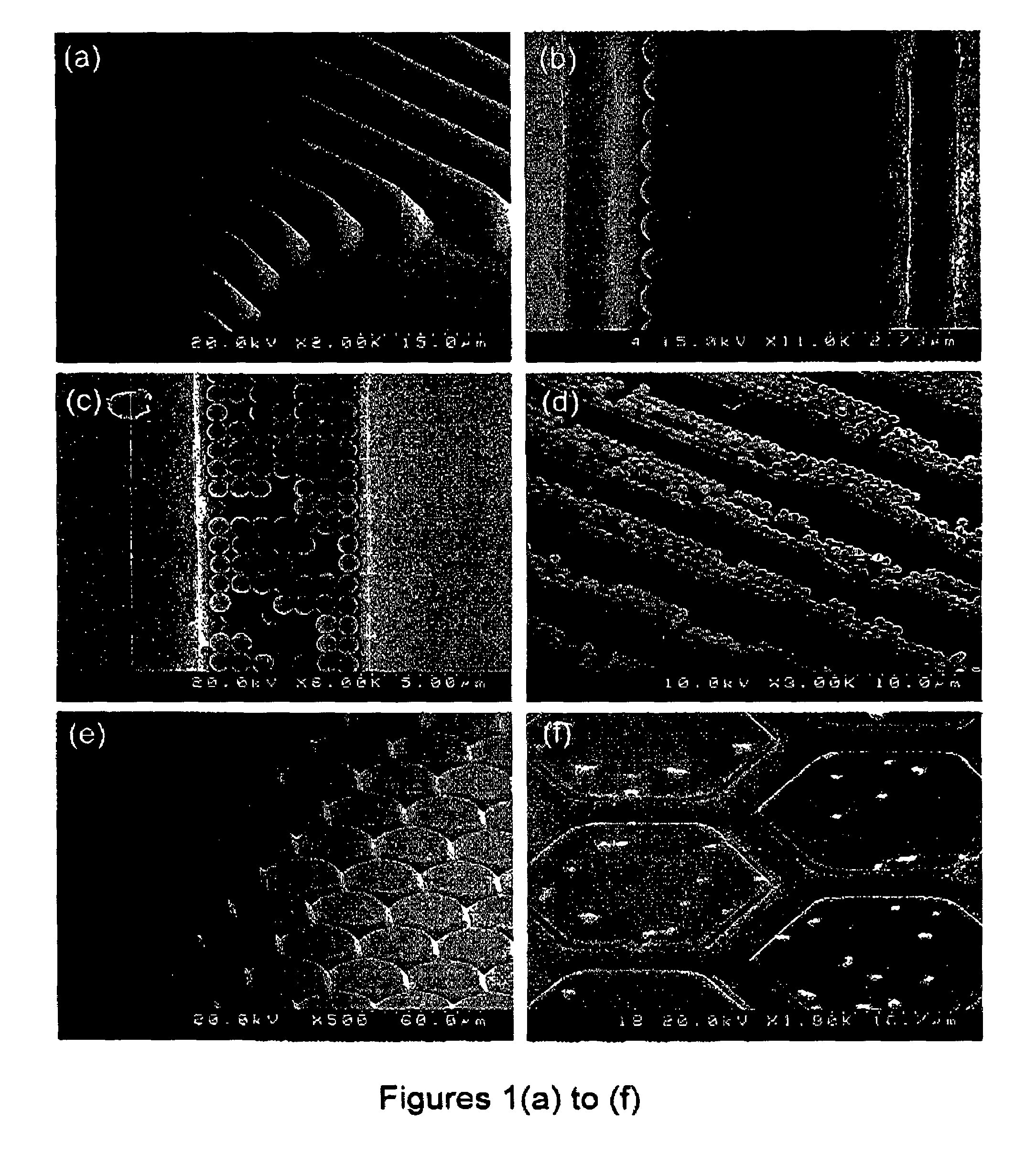Composite materials having substrates with self-assembled colloidal crystalline patterns thereon
a technology of colloidal crystals and composite materials, which is applied in the direction of traffic signals, instruments, roads, etc., can solve the problems of inability of light to propagate in the photonic crystal at wavelengths corresponding to pbg, the gap between the photonic band and the pbg, and the research is still in its infancy, and achieves the effect of photonics
- Summary
- Abstract
- Description
- Claims
- Application Information
AI Technical Summary
Benefits of technology
Problems solved by technology
Method used
Image
Examples
example 4
Spin-coating Colloidal Crystal Clusters Inside Square Pyramid-shaped Pits in Silicon (100) Wafers
[0152]Interestingly, the first micro-spheres observed to nucleate in the square pyramidal-shaped etch pits are singlet, duplet, triplet and quadruplet and so forth type arrangements of micro-spheres located at the apex of the square pyramid pit, some examples being shown in FIGS. 5a, 5b, 6c. These embryonic micro-sphere clusters are found to dominate in the early stages of the spin-coating, colloidal self-assembly process inside the silicon etch pits and when dilute aqueous dispersions of micro-spheres are used. At later stages and with more concentrated dispersions, microspheres close-pack always starting from the apex and continue to grow up the walls and along the edges of the square pyramid-shaped etch pit to eventually fill them with well-ordered patterns of colloidal crystals, FIG. 6a. The edges of the pits generally seem to be filled first with well-ordered micro-spheres and the s...
example 5
Spin-coating Single Crystal Colloidal Crystals Inside Rectangular Pyramid-shaped Pits in Silicon (100) Wafers
[0155]Another attractive and inventive feature of the spin-coating process of this disclosure is the ability to intentionally tune the orientation and lattice structure of the colloidal crystal grown within the etch pits inside the wafer. This observation stems from the effect of the geometry of the etch pits on the nucleation and growth of the colloidal crystal within. A rectangular pyramid-shaped etch pit can be used to illustrate this novel and inventive concept reduced to practice in this disclosure. Because the first micro-spheres to settle in a rectangular pyramid-shaped etch pit most likely settle on the apex line, the number and geometry of this embryonic micro-sphere arrangement depends on the relative sizes of the micro-sphere diameter and the length of the line that defines the apex of the rectangular pyramid-shaped pit. If the arrangement is commensurate, that is ...
example 3
Modulated Thickness Colloidal Crystal Micro-channels
[0190]The grooves described in this example have designed thickness controlled either by etching time of silicon wafer or the thickness of a relief structure in a photo-resist pattern. A method to prepare a vertical wall micro-channel with modulated depth is described herein. FIG. 27 illustrates a procedure for the fabrication of a modulated thickness colloidal crystal. The procedure is similar to the preparation of the wood-pile structure, FIG. 25a. During the heating step for transferring the pattern to the substrate, the oven temperature is set at 180° C., which is higher than the glass transition temperature of the PMMA. The PMMA line structure imprints its pattern on the POMS stamp. By putting this imprinted PDMS stamp on a flat substrate, followed by capillary infiltration of polyurethane (NOA73, Norland) and curing under UV light, a line pattern with modulated steps is formed. After removing the PDMS, the patterned substrate...
PUM
 Login to View More
Login to View More Abstract
Description
Claims
Application Information
 Login to View More
Login to View More - R&D
- Intellectual Property
- Life Sciences
- Materials
- Tech Scout
- Unparalleled Data Quality
- Higher Quality Content
- 60% Fewer Hallucinations
Browse by: Latest US Patents, China's latest patents, Technical Efficacy Thesaurus, Application Domain, Technology Topic, Popular Technical Reports.
© 2025 PatSnap. All rights reserved.Legal|Privacy policy|Modern Slavery Act Transparency Statement|Sitemap|About US| Contact US: help@patsnap.com



